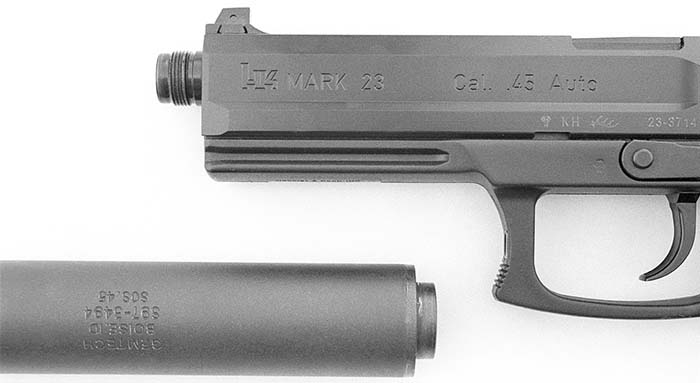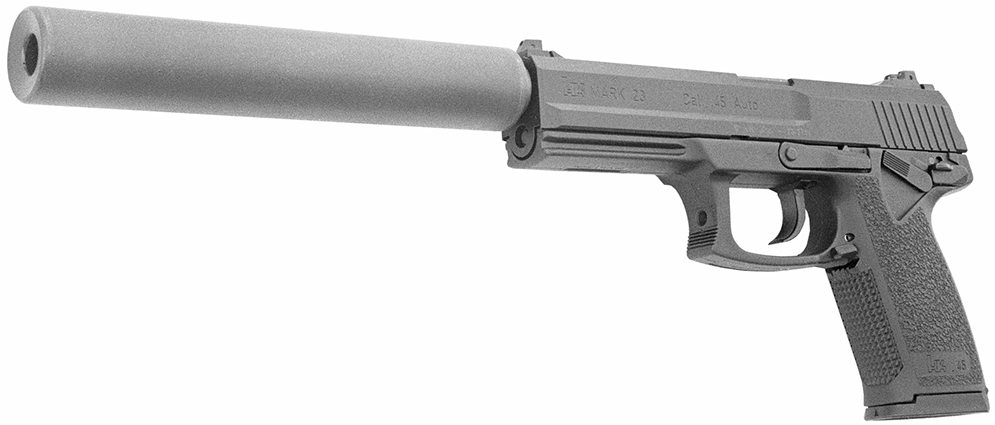Gemtech’s SOS-45 suppressor is short and light enough so it doesn’t need a Nielsen device for reliable functioning on the HK Mark 23, Glock 21, or Colt 1911 pistols. Shown here on the HK Mark 23 pistol.
By Al Paulson
The .45 ACP pistol is undergoing yet another resurgence in popularity as a valuable tool for “close-range interpersonal management” in the United States. Part of this trend can be traced to the U.S. Special Operations Command (USSOCOM) decision to employ the Heckler and Koch Mark 23 pistol and Knight’s Armament Model OHG sound suppressor as an offensive weapon for in extremis missions. Part of this trend can be traced to Congress passing the infamous Violent Crime Control and Law Enforcement Act of 1994 (Public Law No. 103-322, 108 Stat. 1796), which banned the manufacture of magazines with a capacity greater than ten rounds for private ownership. This legislation obliterated the curious euphoria fostered by the popular gun press over the so-called Wunderneun (Wondernine) 9x19mm pistols, which many armed professionals viewed as nothing but dandified .38 Specials with large magazines that fostered a spray-and-pray mentality. After the magazine ban, many people started to realize that they would be better served by a more efficacious cartridge than the 9x19mm in a pistol with legislatively limited magazine capacity. And, finally, part of the renewed interest in the .45 ACP can be traced to the proliferation of concealed carry laws in the 1990s. The net result has been a plethora of outstanding new pistols chambered in .45 ACP: from the HK USP-45 Tactical to the Glock 36. While pistol manufacturers have provided a dizzying array of new .45 pistols, suppressor manufacturers did not provided a wealth of silencing options in .45 caliber.
The few .45 silencers in the marketplace in the late 1990s tended to be large, heavy, and expensive. And they generally needed a recoil enhancement module (called a Nielsen device by industry insiders) to ensure reliable functioning of the pistol. Several years ago, Gemtech introduced a simple, compact, lightweight and affordable .45 suppressor that did not incorporate a Nielsen device. Called the SOS-45, this suppressor has proven to be an important development in the quest for the optimum .45 caliber suppressor.
Making a good .45 caliber suppressor is a much more difficult challenge than designing a 9mm suppressor. Not only does the .45 produce a larger volume of combustion gases (gas volume is directly proportional to powder weight), it’s more difficult to capture, slow, and cool the broad gas stream following behind a .45 caliber projectile. It is unlikely that a suppressor design that works well in 9mm will scale up gracefully to .45 caliber. This challenge is even greater when designing a pistol suppressor (as opposed to a carbine or submachine gun can), since the length and weight of a .45 suppressor are likely to inhibit the reliability of a pistol.
Adding a Nielsen device to the suppressor can solve the reliability issue. Some Nielson devices feature a piston attached to the barrel, while others feature a piston attached to the suppressor. A properly designed Nielsen device is high art, requiring an investment of substantial funds for R&D. Furthermore, actually manufacturing a quality Nielsen device also requires special alloys, manufacturing processes, and a rigorous quality control program, which all add to the price.
Perhaps the bottom line is that any Nielsen device does add moving parts (spring and piston) to the design, violating the KISS principal—which is a corollary to Murphy’s Law well known to both engineers and armed professionals. The presence of a Nielsen device also adds to the length and weight of the suppressor, which can slow presentation from a holster or slow the speed of target acquisition from a ready position. Gemtech’s SOS-45 suppressor is short and light enough so it doesn’t need a Nielsen device for reliable functioning on the HK Mark 23, Glock 21, or M1911A1 pistols. Its compact size and small diameter also facilitate rapid presentation and target acquisition.

Fabricated from 6061-T6 and 2024-T6 aluminum, the SOS-45 suppressor is 7.1 inches (18.1 cm) long and just 1.25 inches (3.1 cm) in diameter. Finished in a nonreflective black hardcoat anodizing, the suppressor weighs a remarkably light 7.0 ounces (200 grams), providing an outstanding efficiency to weight ratio. Seven baffles of advanced asymmetrical design direct combustion gases away from the central axis of the suppressor and generate more turbulence than suppressors of conventional (i.e., symmetrical) design. The suppressor is available with one of two thread pitches at the time of this writing: 16x1mm RH for the HK Mark 23 pistol, and 0.578×28 TPI for the Colt Model 1911 and its clones. A few prototypes have also been threaded for the HK USP-45 Tactical pistol (16x1mm LH).
Like all diminutive suppressors designed for pistols of centerfire caliber which don’t use elastomer wipes, the SOS-45 uses artificial environment technology, which is a fancy way of saying it’s a wet can. The pistol is issued with a 10 ounce tube of Lubriplate No. 105 grease for this purpose. Simply insert the 2 inch (5 cm) tip into the rear of the suppressor and squeeze about a teaspoon (5 cc total) of grease into the spaces behind the rearmost two baffles of the suppressor. Don’t clog the bullet passages with grease or you’ll adversely affect accuracy and increase the back pressure generated by the can. The grease should be replenished every two magazines (20 rounds), which should be plenty for any real-world tactical scenario.
Performance
I tested the performance of the Gemtech SOS-45 on an HK Mark 23 pistol using the specific equipment and testing protocol advocated at the end of Chapter 5 in the book Silencer History and Performance ($55 postpaid, Wideworld, Dept. SAR, P.O. Box 1827, Conway, AR 72033). The microphone was placed 1.00 meter to the left of the suppressor or muzzle. The ambient temperature during the testing was 68°F (20°C), and the ammunition was UMC 230 grain (15.0 gram) ball.
The unsuppressed pistol produced a sound pressure level (SPL) of 162 decibels, while the suppressed pistol produced an SPL of 131 dB. This represents an impressive net sound reduction of 31 dB. First round pop was -2.6 dB, so the first round was quieter than the second. Both the HK Mark 23 and Colt Model 1911 pistols functioned with absolute reliability when fitted with the SOS-45. The only fly in the proverbial ointment was when the SOS-45 suppressor was fitted to the new HK USP-45 Tactical pistol, which operated in a sluggish manner with the can and would sometimes fail to eject a spent case. I think this problem could be cured when an aftermarket main operating (recoil) spring becomes available which produces somewhat less force—perhaps 3 pounds or 1.4 kg less than a factory spring.
The SOS-45’s virtues are manifest: it is quiet, short, small in diameter, and light in weight. Furthermore, it has no moving parts and it is affordable. An unrepentant miser like myself tends to have a particular affection for a product like Gemtech’s SOS-45 that delivers outstanding performance at a modest price. The SOS-45 makes an excellent choice for suppressing the HK Mark 23 and P9S pistols, or for the Colt Model 1911A1 and its clones.
Gemtech, Dept. SAR
P.O. Box 3538
Boise, ID 83703
phone 208-939-7222
fax 208-939-7804
catalog $5 unless requested
on agency letterhead
URL http://www.gem-tech.com/
| This article first appeared in Small Arms Review V4N9 (June 2001) |











